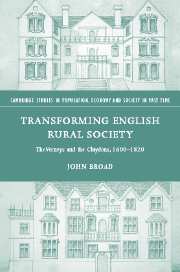Book contents
- Frontmatter
- Contents
- List of figures
- List of tables
- Preface
- Acknowledgements
- Note on editorial practice
- List of abbreviations
- 1 Introduction
- Part I Re-establishing a gentry family 1600–1657
- 2 A gentry family in county and court society 1603–1642
- 3 The Civil War and Interregnum 1642–1657
- 4 The creation of an enclosed estate 1600–1657
- Part II The shaping of family and village 1657–1740
- Part III The great estate and estate communities c. 1700–1820
- Appendix A Sir Ralph Verney's confessional letter of 1650
- Appendix B The genealogy of the Verney family
- Bibliography
- Index
4 - The creation of an enclosed estate 1600–1657
Published online by Cambridge University Press: 03 July 2009
- Frontmatter
- Contents
- List of figures
- List of tables
- Preface
- Acknowledgements
- Note on editorial practice
- List of abbreviations
- 1 Introduction
- Part I Re-establishing a gentry family 1600–1657
- 2 A gentry family in county and court society 1603–1642
- 3 The Civil War and Interregnum 1642–1657
- 4 The creation of an enclosed estate 1600–1657
- Part II The shaping of family and village 1657–1740
- Part III The great estate and estate communities c. 1700–1820
- Appendix A Sir Ralph Verney's confessional letter of 1650
- Appendix B The genealogy of the Verney family
- Bibliography
- Index
Summary
The Verneys focused their interest on their Middle Claydon estate in the early seventeenth century, particularly after Claydon House became their country residence in 1620. They quickly adopted estate policies that modernised property rights, tenures, farmsteads, and farming practices. By 1657 Middle Claydon had been transformed into a parish with a single landlord, enclosed fields without common rights, a country house with deer park, and ring-fenced farmsteads held by leaseholders or tenants-at-will at rack rents. The process had significant effects on the villagers and their relationships with their parson and landlord. Middle Claydon was one of hundreds of communities across England where analogous changes took place in the seventeenth century. But it is one of the few in which the decision-making process and human impact can be analysed in detail.
The character of Middle Claydon's landscape was heavily influenced by the heavy clayland subsoil, and the legacy of Bernwood forest. In 1600 the ancient bounds of Bernwood still contained considerable tracts of woodland and common waste which had in medieval times been shared between several parishes. That small part of Bernwood on the Oxfordshire/Buckinghamshire borders that remained Royal Forest in 1600 shared its resources with several Otmoor parishes, and also with Shabbington, several miles to the south, until these purlieu rights, as they were called, were extinguished in the 1590s. Kingswood, to the north-west, also provided shared resources. Similar patterns existed around the Claydons.
- Type
- Chapter
- Information
- Transforming English Rural SocietyThe Verneys and the Claydons, 1600–1820, pp. 48 - 80Publisher: Cambridge University PressPrint publication year: 2004



